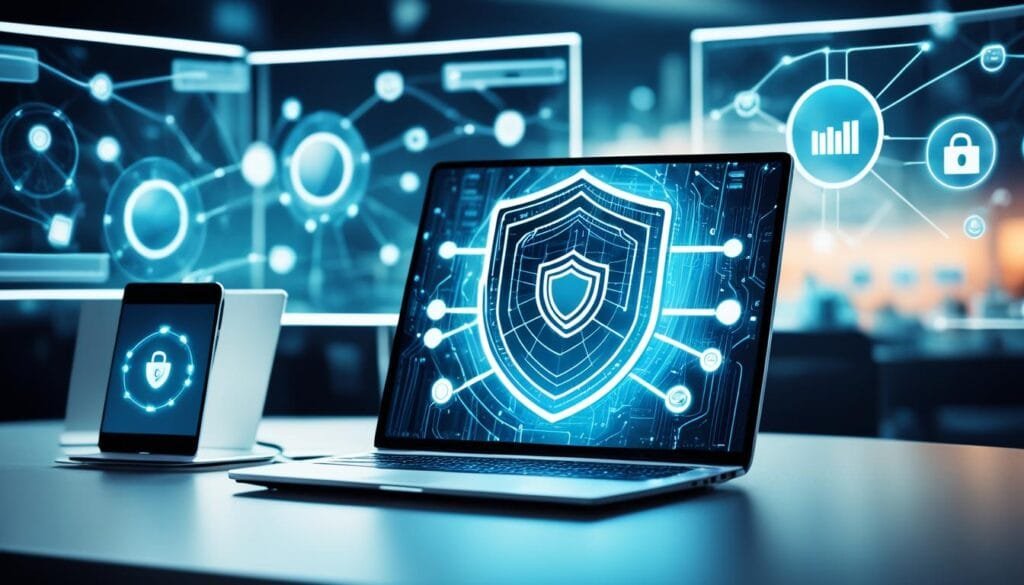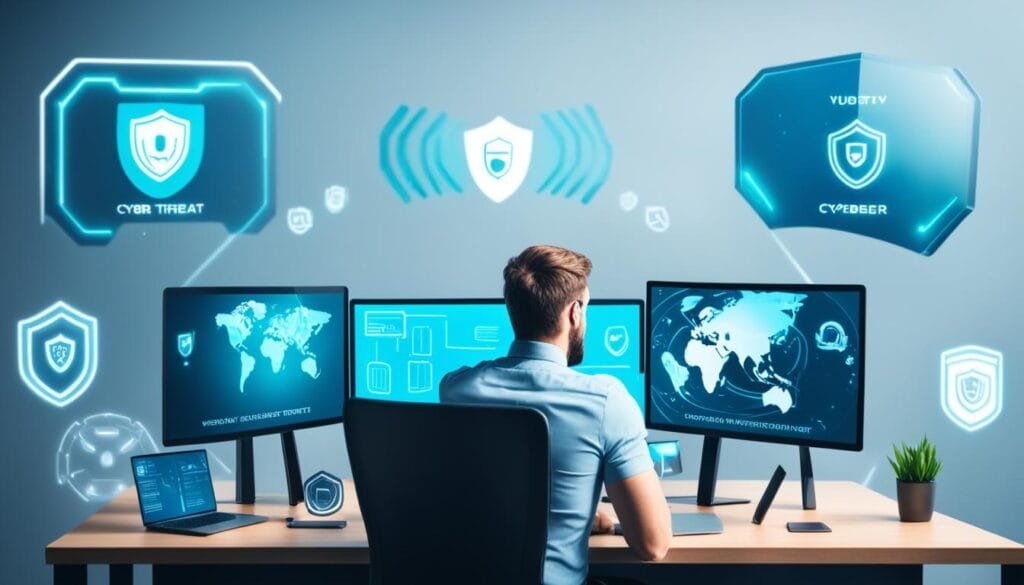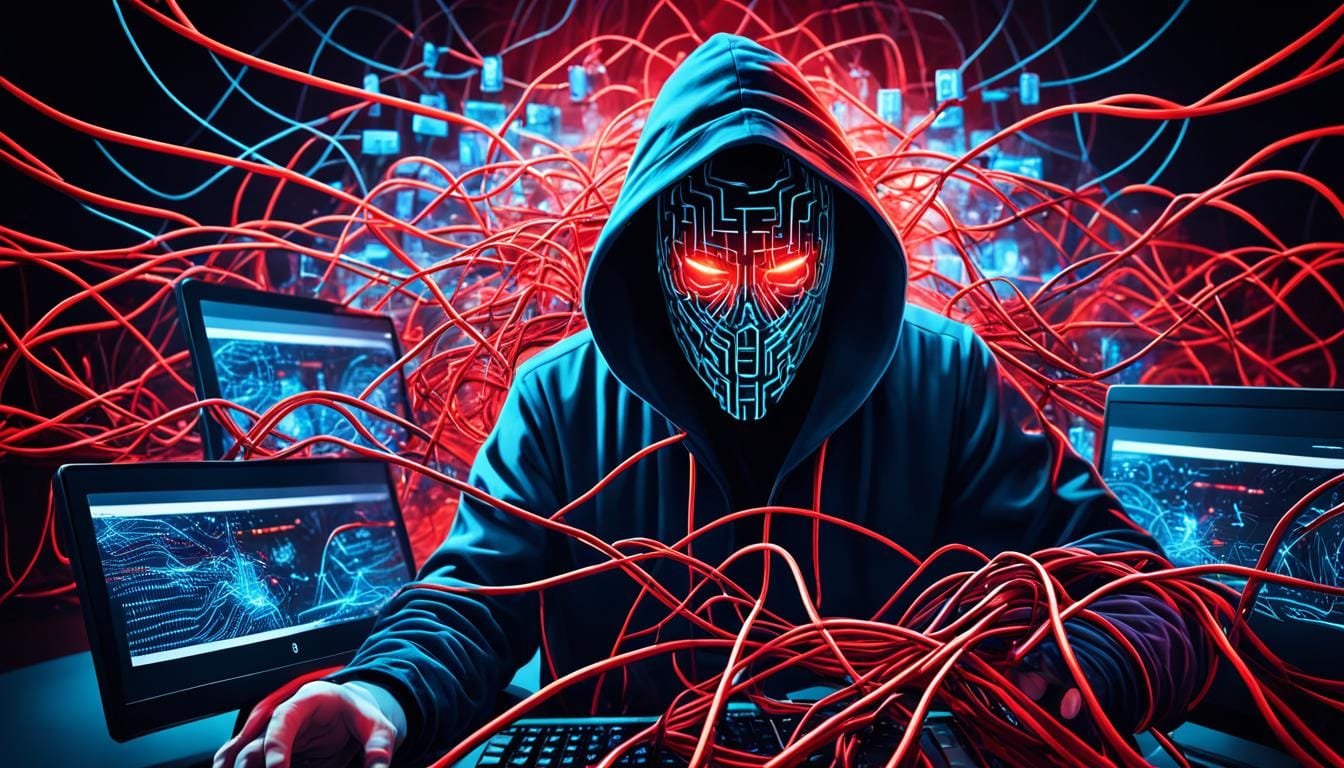A recent survey found that 37% of US job seekers want fully remote jobs in 2024. The shift to remote work is changing how we work, and companies must protect their digital spaces from cyber threats. In 2023, cyberattacks jumped by 104%, showing the need for strong security in remote work.
This guide will cover the best ways to keep your remote team safe and protect your company from cyber threats in 2024. We’ll talk about using the latest security tech and building a culture that values cybersecurity. We aim to give you the tools and strategies to stay safe online and protect your data and reputation.
Key Takeaways
- Cybersecurity threats are on the rise, with a 104% increase in cyberattacks in 2023.
- Remote work environments are more vulnerable to cyber threats, such as ransomware, phishing, and data breaches.
- Implementing robust security measures, including VPNs, multi-factor authentication, and endpoint security solutions, is crucial.
- Continuous employee training and awareness are essential to mitigate cyber threats in remote work settings.
- Adopting a zero-trust architecture and leveraging AI/ML tools can enhance real-time threat detection and response.
Understanding Cyber Threats
The world of cyber threats is huge and always changing. It’s key to know the different types of threats and who creates them. These threats can lead to big problems, like stealing data, losing money, or even harming our safety.
What Constitutes a Cyber Threat?
A cyber threat is any harmful action aimed at damaging data or disrupting our digital lives. These threats can come from many places. This includes countries, terrorists, corporate spies, criminals, hacktivists, people who are upset, and skilled hackers.
Types of Cyber Threats
- Malware, including ransomware, spyware, and trojans, designed to perform malicious tasks on devices or networks
- Phishing attacks that attempt to lure individuals into providing sensitive data
- Distributed Denial of Service (DDoS) attacks aimed at disrupting computer networks
- Zero-day exploits that leverage unknown vulnerabilities to gain unauthorized access
- Advanced Persistent Threats (APTs) involving unauthorized access and extended periods of undetected presence
- Supply chain attacks that target third-party software or services to infiltrate organizations
Cyber threats can cause big problems, like losing money, harming reputations, or even making our critical systems fail. It’s important for everyone to understand these threats. This helps us take steps to protect ourselves and stay safe from these dangers.
Cyber Threats Actors and Their Motivations
The world of cybersecurity is complex and always changing. Many different groups pose risks to people, businesses, and governments. It’s important to know what motivates these groups to protect ourselves online.
Some nation-states have advanced cyber warfare tools. They can harm national security in big ways. These groups might want to spy, sabotage, or disrupt important systems for political, military, or economic reasons.
Terrorist groups use the internet to push their beliefs. They attack online to scare people, disrupt activities, and shake society’s trust. Their attacks can be simple or complex, like denial-of-service attacks or spreading malware and ransomware.
Corporate spies and organized crime groups are a big threat too. They steal secrets and money from businesses. They aim to get ahead or make more money illegally.
Hacktivists attack online for political or social reasons. They try to show their point by breaching data, changing websites, or causing DDoS attacks. Their goal is to highlight what they see as wrong.
Insider threats come from within an organization. They can be employees who are upset or careless with sensitive info. These insiders can accidentally or on purpose put a company’s security at risk.
Knowing what motivates these groups helps us make better cybersecurity plans. By understanding the risks and taking strong steps to protect ourselves, we can stay safe in the digital world.
Common Cyber Threats in 2024
In 2024, cybersecurity experts highlight several key cyber threats. These include malware and ransomware attacks, as well as phishing and social engineering tactics. Organizations and individuals must be ready to face these threats.
Malware and Ransomware Attacks
Malware is harmful software that can corrupt data, take control of systems, and disrupt critical infrastructure. Ransomware is a type of malware that locks computer systems or data. It demands a ransom before giving back access. In 2023, ransomware attacks grew by 50% from the previous year. This trend is expected to continue in 2024.
Phishing and Social Engineering Attacks
Phishing attacks trick people into sharing sensitive info through fake emails or websites. Social engineering uses psychological tricks to get unauthorized access to systems and data. These attacks have become more sophisticated, with targeted messages designed to fool specific individuals.
The cost of cybercrime hit $8 trillion in 2023, with losses reaching over $250,000 per second. Experts predict this could rise to $10.5 trillion by 2025. These threats can cause huge data breaches, financial losses, and disrupt critical systems. It’s crucial to take steps to protect against these threats.
| Cyber Threat | Impact | Trend |
|---|---|---|
| Malware and Ransomware Attacks | Corruption of data, system takeover, disruption of critical infrastructure | Ransomware activity up 50% year-over-year in 2023 |
| Phishing and Social Engineering Attacks | Theft of sensitive information, unauthorized access to systems | Highly tailored and convincing spear phishing attacks targeting individuals |
Emerging Cyber Threats
The digital world is always changing, and so are the cyber threats we face. Supply chain attacks and advanced persistent threats (APTs) are now major concerns for businesses and individuals. These threats pose big challenges.
Unraveling the Complexity of Supply Chain Attacks
Supply chain attacks are a big worry. They happen when hackers target a third-party vendor in an organization’s supply chain. This gives them access to the target’s systems and data. A 2023 study found that only 35% of companies fully test their DevOps processes, making them easy targets.
These attacks can cause huge problems, like what happened in 2021. Hackers used a third-party contractor named Socialarks to expose personal info from over 214 million Facebook, Instagram, and LinkedIn accounts.
Unmasking the Threat of Advanced Persistent Threats (APTs)
APTs are another big threat. They are unauthorized users who stay in a system or network without being detected. They can gather sensitive info or disrupt operations. The 2023 Verizon DBIR says APTs cause 21% of breaches due to errors.
These attacks are getting more common as hackers and countries get better at avoiding security. Companies need to stay updated and use strong security to fight these threats.
| Cyber Threat | Description | Impact |
|---|---|---|
| Supply Chain Attacks | Compromising a third-party vendor in an organization’s supply chain to gain access to the target’s systems and data. | Far-reaching consequences, as seen in the 2021 incident where hackers exposed personal information from more than 214 million social media accounts. |
| Advanced Persistent Threats (APTs) | Unauthorized users who gain access to a system or network and remain there undetected for an extended period, allowing them to gather sensitive information or disrupt operations. | Accounts for 21% of error-related data breaches, highlighting the importance of addressing this threat. |
As technology changes, we must stay alert and proactive in cybersecurity. Knowing about threats like supply chain attacks and APTs helps businesses protect their data from sophisticated cyber attacks.
Cyber Threats Targeting Remote Work Environments
The move to remote work during the COVID-19 pandemic has shown new weaknesses that cyber threats can use. Remote workers often use personal devices and home networks that aren’t secure. This makes it easier for hackers to get in.
Cybercriminals use malware, phishing attacks, and other methods to get into these remote work setups. They aim to steal data or disrupt work.
A February 2023 survey by Pew Research Center found 35% of workers who could work from home were doing so full time. Another 41% had a mix of remote and office work. Only 4% of CEOs in late 2023 wanted all workers back in the office full time, according to “C-Suite Outlook 2024: Leading for Tomorrow” by The Conference Board.
Cyberattacks jumped by 104% in 2023, says cybersecurity vendor Armis in “The Anatomy of Cybersecurity: A Dissection of 2023’s Attack Landscape.” A 2023 survey by TechTarget’s Enterprise Strategy Group and ISSA International found 71% of 301 ISSA members facing challenges due to a lack of skilled cybersecurity workers.
Remote work brings risks like bigger attack surfaces and less control over data. It also makes it harder to follow data laws and increases the chance of phishing and AI-driven attacks. Workers face risks from unsecured devices, webcam hacking, and Zoombombing.
Since COVID-19 started, data breaches have gone up by as much as 300%. Ransomware attacks have seen a 90% increase. Hackers target remote workers to get into systems and steal data. Law firms have been hit by these cyber attacks.
Remote workers are often tricked by phishing emails, which can put their work at risk. Not using enough security software and using unauthorized tech can also be a problem. It’s important to test networks for vulnerabilities and keep devices and Wi-Fi secure.
To protect data, use strong passwords, multi-factor authentication, and encrypted VPNs. Training employees on security and keeping software updated is key. Having tech support ready to help remote workers is also important.
Having a plan for responding to cyber incidents is crucial. Checking cyber insurance policies for remote worker coverage is a good idea. Law firms must follow data security laws to avoid cyber risks.
Securing Remote Access
With more people working from home, keeping remote access safe is key. Using virtual private networks (VPNs) and multi-factor authentication can help. These steps protect your company from cyber threats.
Virtual Private Networks (VPNs)
VPNs make a secure tunnel between your device and your company’s network. This means all your data stays safe from others. With a VPN, you’re safe from cyber threats like spying, fake attacks, and unauthorized access.
VPNs are vital for keeping remote work safe. They let employees work securely from anywhere.
Multi-Factor Authentication
Multi-factor authentication (MFA) is also key for secure remote access. It asks for more proof, like a code or your face, to get into your company’s resources. This stops hackers from getting in and makes sure only real people can access your network and data.
Using VPNs and MFA together makes your remote access much safer. It makes it hard for hackers to get into your systems and steal your data. These steps are important for keeping your remote work safe from cyber threats in 2024 and later.

“Securing remote access is essential in the era of remote work. Virtual private networks and multi-factor authentication are powerful tools in the fight against cyber threats.”
Protecting Remote Devices
Remote work is becoming more common, making it vital to protect the devices of remote workers. Using endpoint security and data encryption is key to fight cyber threats. These methods help keep remote devices safe.
Endpoint Security Solutions
Antivirus software and firewalls are key to endpoint security for remote devices. They stop malware like viruses and ransomware. This keeps devices safe and protects sensitive data.
Data Encryption
Data encryption helps protect devices if they are lost or stolen. It makes sure data is safe, even if someone else gets their hands on it. This is very important for remote workers using their personal devices for work.
Using strong endpoint security and data encryption keeps remote devices safe from cyber threats. This helps protect the work and valuable data in today’s digital world.
| Device Type | Vulnerability Rate |
|---|---|
| iPhone | 17% |
| Android | 12% |
| Mac | 16% |
“Protecting remote devices is a critical component of cybersecurity in today’s work environment. Implementing robust endpoint security and data encryption solutions is essential to safeguarding sensitive information and mitigating the risks posed by cyber threats.”
Cyber Threats Training for Remote Employees
In today’s world, keeping our remote workers safe from cyber threats is key. Cybersecurity training for remote employees is vital for protecting our companies. I want to share some important tips and strategies with you.
Remote workers often use unsecured home networks, making them more at risk. This includes threats like phishing, malware, and unauthorized access. Using personal devices for work can also put data at risk if not protected right. Tools and services for remote work can be vulnerable if not set up securely.
To tackle these issues, we need to give our remote employees special cybersecurity training. This should teach them how to set up secure home networks and use personal devices safely. It should also teach them how to spot phishing and social engineering tricks. Keeping up with the latest cyber threats and best practices is also key.
Simulated phishing tests can check how well our employees can spot and handle these attacks. This gives them quick feedback and helps them improve. We should also focus on using collaboration tools safely, keeping passwords strong, using two-factor authentication, and sharing files securely.
It’s important to have clear rules for remote work security and make sure everyone follows them. By building a culture of cybersecurity awareness, we encourage our remote employees to report any suspicious activities. This makes them our first line of defense against cyber threats.
Cybersecurity training is not just a one-time thing. It’s an ongoing effort. By making it a must for all employees, no matter their role, we can get better at handling cyber threats. This helps protect our remote work setups.

Incident Response and Disaster Recovery
Today’s world is full of cybersecurity threats. Organizations need to be ready to handle cyber incidents and bounce back from data breaches or system problems. Having good incident response and disaster recovery plans is key. These plans help lessen the blow of a cyber attack, get systems and data back, and keep business running smoothly.
Incident response plans tell you how to spot, check out, and stop cyber threats. They make sure there’s a clear plan to deal with a security breach. Disaster recovery plans, on the other hand, are about getting back critical data and systems after a cyber attack or other big problem.
A data breach can cost a business up to $4.45 million. Having both incident response and disaster recovery plans helps a lot. These plans cut down on lost time, money, and keep important business work going.
| Metric | Impact |
|---|---|
| Infrastructure Failure | Up to $100,000 per hour |
| Application Failure | $500,000 to $1 million per hour |
| Small Businesses Not Reopening After a Disaster | 40% |
| Small Businesses Failing Within a Year After a Disaster | 25% |
Good incident response and disaster recovery plans need steps for spotting threats early, backing up data, and communicating well. They also need regular tests and practice runs. By putting money into these plans, companies can get stronger and handle cyber attacks and other big issues better.
Cyber threats are getting more common and complex. That’s why planning for incident response and disaster recovery is so important. By tackling these areas ahead of time, businesses can guard their assets, reduce downtime, and stay strong against cyber risks.
Monitoring and Threat Detection
It’s vital to have strong monitoring and threat detection to catch cyber threats as they happen. Tools like IBM Security QRadar use advanced analytics, including machine learning and studying user behavior. This helps spot unusual activities in a network.
Security Information and Event Management (SIEM)
SIEM systems give a clear view of what’s happening in a network. They help security teams spot, look into, and stop cyber incidents fast. This reduces the chance of attacks and lessens their effect on a company.
These tools look at a lot of data from different sources. They check network traffic, system logs, and security device data. This helps find patterns and catch activities that might mean a security issue.
Over time, how we find threats has changed a lot. In the 1970s, we used rules to spot threats. By the late 1980s, we started using heuristic-based methods to fight new threats. The 1980s brought signature-based systems to stop known threats.
In the late 1990s, anomaly detection systems came along to improve threat finding. The 2000s saw AI change threat hunting. Now, AI like deep learning looks through big datasets for suspicious patterns. This helps security teams find hidden risks and improve their defenses.
Machine learning can quickly spot new and complex threats. AI’s adaptive learning makes threat detection better over time. AI solutions cut down on false alarms and reduce the need for manual checks. This lets security teams focus on the biggest threats.
| Threat Detection Techniques | Timeline | Key Advancements |
|---|---|---|
| Rule-based System | 1970s | Relied on predefined rules to detect threats |
| Heuristic-based Threat Detection | Late 1980s | Emerged to combat evolving threats |
| Signature-based Approach | 1980s | Helped stop known cyber threats |
| Anomaly Detection Systems | Late 1990s | Improved threat detection capabilities |
| AI-powered Threat Hunting | Late 2000s | Revolutionized the field of threat detection |
| Advanced AI Algorithms (Deep Learning) | Present | Analyze vast datasets for suspicious patterns |
Keeping up with cyber threats is key for companies to protect their assets. Using SIEM solutions and the latest in threat detection helps security teams stay ahead. This lets them handle incidents faster and more accurately.
Conclusion
Securing remote work against cyber threats is a big challenge for companies in 2024. By knowing the different threat actors and their threats, businesses can make a strong security plan. This plan should cover securing remote access, protecting devices, training staff, and having good incident response and threat detection.
By following these best practices, companies can keep their remote work safe from data breaches and other cyber attacks. It’s key to be proactive and have a strong defense against cyber threats. This is because threats are always changing and attacks can cause big problems.
Staying alert, using the latest security tech, and teaching remote workers about cybersecurity is important. This helps businesses deal with cyber threats. As we go forward, it’s vital for companies to keep improving their cyber security. They need to keep up with the changing threats.
FAQ
What constitutes a cyber threat?
A cyber threat is a harmful act aimed at damaging data or disrupting digital life. These threats come from various groups like hostile nations, terrorists, corporate spies, and hackers.
What are the common types of cyber threats?
Common threats include malware, phishing, DDoS attacks, and ransomware. Other threats are zero-day exploits, APTs, supply chain attacks, and intellectual property theft.
Who are the main cyber threat actors and what are their motivations?
Threat actors have different reasons for their actions. Nation-states use cyber warfare for political goals. Terrorists aim to support their ideologies. Corporate spies steal data for profit. Hacktivists back political causes, and insiders may act out of anger or carelessness.
What are the most common and dangerous cyber threats in 2024?
In 2024, malware and ransomware are top threats. Phishing attacks also pose a big risk. Malware corrupts data, while ransomware demands money to unlock systems. Phishing tricks people into sharing sensitive info.
What are the emerging cyber threats?
New threats include supply chain attacks and APTs. Supply chain attacks target vendors to access systems. APTs are stealthy threats that stay undetected to steal data or disrupt operations.
How has the shift to remote work during the COVID-19 pandemic created new vulnerabilities to cyber threats?
Remote work has made it easier for cyber threats to exploit vulnerabilities. Workers use personal devices and cloud tools, making them vulnerable. Cybercriminals target these with malware and phishing to steal data or disrupt work.
What measures can organizations implement to secure remote access?
Use VPNs and multi-factor authentication to secure remote access. VPNs encrypt data, and multi-factor adds an extra security layer. This makes it harder for unauthorized access.
How can organizations protect remote devices from cyber threats?
Use endpoint security tools like antivirus and firewalls to protect devices. Data encryption keeps information safe, even if a device is lost.
Why is cyber threats training for remote employees important?
Training remote workers on cyber threats is key to security. It teaches them to spot phishing, understand security, and handle data safely. This helps protect remote work environments.
How can organizations effectively respond to and recover from cyber incidents?
Have incident response and disaster recovery plans ready. These plans help contain attacks, restore systems, and keep business running. They include steps for detecting threats and keeping operations going.
What tools and technologies can organizations use to monitor and detect cyber threats?
Use SIEM solutions like IBM Security QRadar for threat detection. These systems use machine learning to spot threats in real-time. They provide detailed analytics to help security teams act fast.


